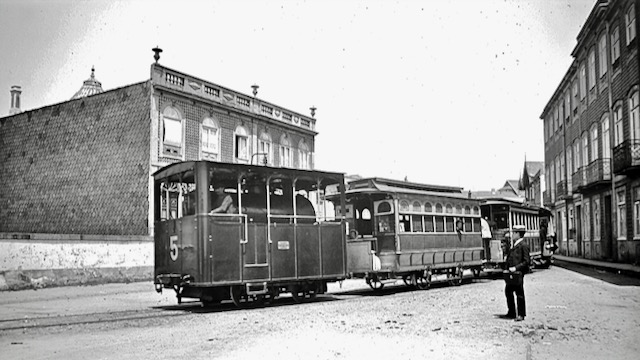
In Porto, like in most cities before electric trams were introduced, horse trams provided the urban public transport, although in Porto more often mules were used. Steam trams were used in many cities too, most on busy suburban routes. Porto was one of the cities in Europe using steam locomotives for trams. This page is about the steam trams of Porto that operated in the city for 36 years. This page is about the history of the steam tramline and the locomotives used, there is a separate page about the tram vehicles that were hauled not only by the locomotives, but also by mules and electric trams.
Prelude
In 1872 the first tramline was opened in Porto by the Companhia de Carril Americano do Porto à Foz e Matosinhos (CCA). The “Americano” referred to the “American” system of rails laid in the existing road with vehicles pulled by horses. The route of this line was along the border of the river Douro until the mouth (Foz means mouth of the river) and then along the Atlantic coast to the at that time still small fishermen village of Matosinhos. In Matosinhos the line used the Rua Juncal de Cima, nowadays Rua Brito Capelo.
Two years later, in August 1874, a rival company opened its own line from the city centre and Boavista to Foz. The route went via Avenida da Boavista (at that time not yet reaching Castelo do Queijo) until Fonte da Moura and through the Campo das Ervilhas to Foz where the terminus was at Cadouços. The first part of the route through Campo das Ervilhas became Rua Correia de Sá and a viaduct had to be made to cross Rua de Tânger (then still Rua de Serralves). The support wall at one side still exists but the viaduct is replaced by a longer and wider one. This company, the Companhia Carris de Ferro do Porto (CCFP), also developed an urban network of mule trams.
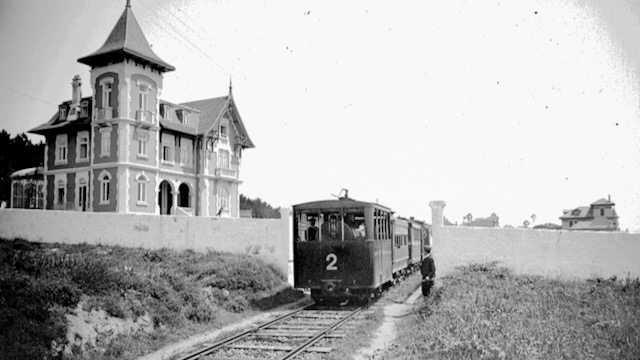
Trials
In December 1877 and/or January 1878 the CCFP tested a steam tram locomotive of Winterthur, followed February/March 1878 by one of Henschel for use on the line Boavista – Foz (Cadouços). The Winterthur was likely the one tested before by the Tramways du Nord in Paris. From Porto it went to Lisboa where also trials were done. Perhaps finally it went to Genève.
It appears the CCFP was very satisfied with the Henschel locomotive (works number 964, the first tram locomotive made by Henschel). They promised (letter dated 27 March 1878) Henschel to buy it with three more locomotives if the Porto Municipality gave permission for its use. In another letter of 27 March 1878 it was told that the locomotive was going to Lisboa for trials because it was already in Portugal. In Lisboa the trials with the locomotives of Winterthur, Henschel and also one of Merryweather that wasn’t tried in Porto, didn’t result in acquiring steam tram locomotives. Only in 1889 the Lisboa tram company bought two Merryweather locomotives, but they were already disposed in 1892.
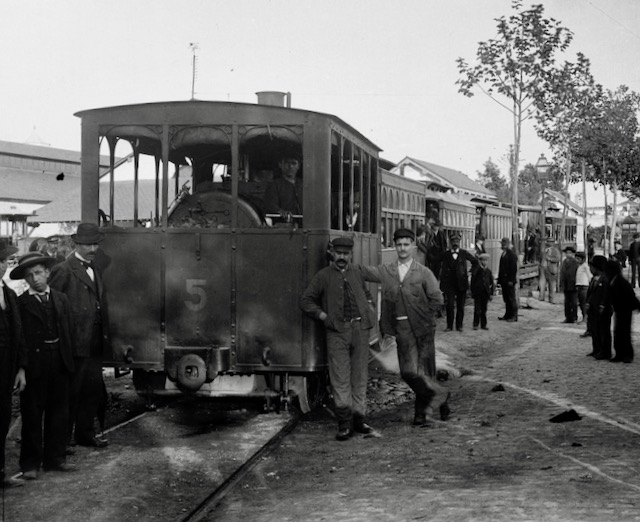
Likely the CCA was alarmed by the intentions of their competitor and asked Henschel for a locomotive for trials too. The second tram locomotive Henschel made, works no.972, was tested by the CCA in the second half of May 1878. The CCA announced the trials to the municipality in a letter of 15 May 1878 to be done on Sunday 19th at noon from Rua dos Ingleses (now Infante) to Matosinhos.
On 27 June 1878 the Porto Municipality gave both companies permission for the use of steam locomotives on the sections West of their respective depots: Boavista of the CCFP and Ouro of the CCA. For the CCFP this was what they wanted and the promise to Henschel to buy four locomotives was fulfilled. For the CCA however it meant they could only use locomotives on the short section between Ouro and Foz. The section from Foz to Matosinhos had at that time only little traffic with once an hour a mule tram, that didn’t justify the use of locomotives. So the CCA didn’t acquire locomotives.
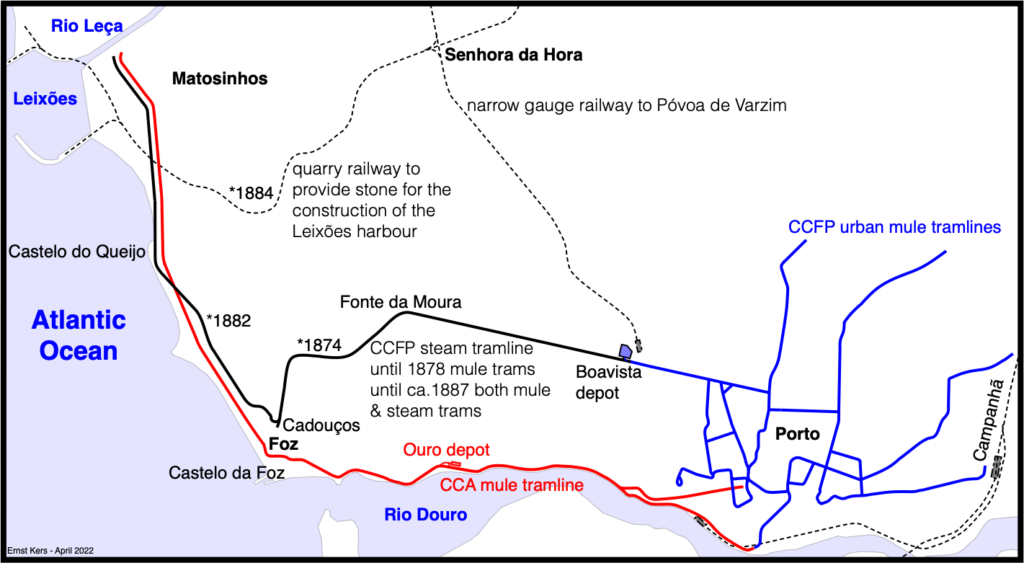
The first locomotives and the early steam tram years
Henschel delivered to the CCFP the locomotives with the works numbers 964 (returning from the trials in Lisboa), 972 (was still in Porto after the trials of the CCA) and 994-995. In the literature1 works no.986 is called to have gone to Porto too, but the original bookkeeping and correspondence in the archives of the Porto tram company are very clear: the nos. 964, 972, 994 and 995 are all administered multiple times, but 986 never. It appears that the Henschel archives are ambiguous about 986. Likely it was first destined for Porto but 986 went to the local tram company of Henschel’s home town Kassel. The Cassel Tramways Co.Ltd was owned by London based Jay & Comp. and had bought locomotives from Merryweather. In the boardrooms of Henschel they cannot have been happy with this and delivery of a locomotive to the local tram likely had priority above sending it to Portugal.
During the first years the steam locomotives were in Porto only used in the Summer period during daytime when traffic was heavy. The rest of the time still mules were used to pull the tramcars. Normally tramcars hauled by mules from the Campanhã railway station and the city centre were at Boavista attached to the locomotive and in the opposite direction mules were taking over the tramcars from the locomotives. Since 1903 electric trams hauled trailers between Carmo and Boavista where the latter were attached to the steam trams.
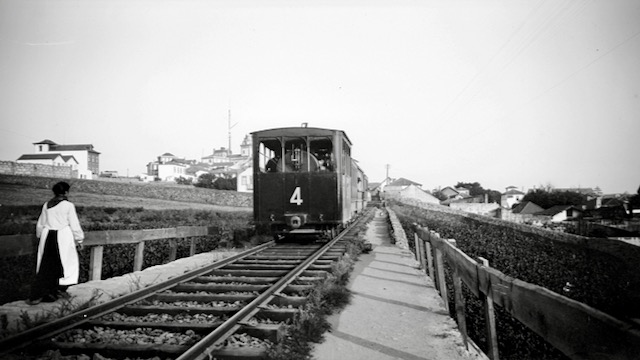
Extension of the line
In May 1881 the CCFP got permission to extend its line Boavista-Foz to Matosinhos, perhaps in anticipation of the large works of the construction of the moles to make the harbour of Leixões. These works, done about 1884 to 1890, and the industrialisation of the area nearby the new harbour caused Matosinhos to grow from a small village into a populated city. The new line was built by Kopke de Carvalho e Ca and opened on 25 May 1882.
With this extension the line was doubled in length to 8.9 km. In Foz some infrastructure had to be made: a viaduct across Rua Fonte da Luz, a tunnel under the Monte da Luz (still existing), a viaduct across the Rua da Agra (one support wall still exists) and an embankment made of stone (still existing though hardly recognisable because of the landfill done at one side). The new line crossed the line of the CCA just South of Castelo do Queijo and was in Matosinhos in the Rua Juncal de Baixo (now Rua Roberto Ivens) and terminated near the bank of the river Leça.
Initially many trams still terminated at Cadouços. Only once an hour the tram continued to Matosinhos. But with the growth of Matosinhos this changed and by 1889 all trams went to Matosinhos.
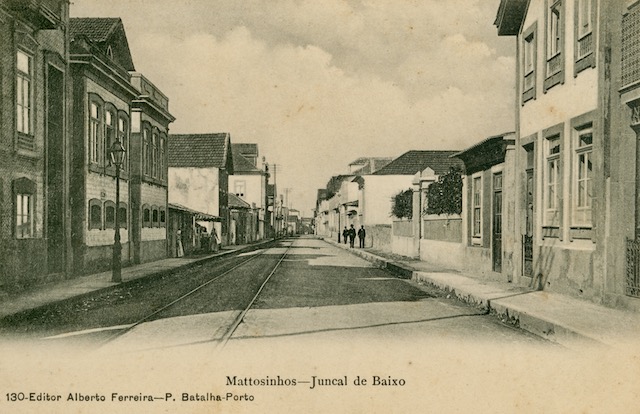
Most of the line between Boavista and Cadouços (4.5 km) was double track, the extension to Matosinhos (4.4 km) was most single track except for an about 500 m long double track section in Rua de Gondarém. In 1884 the maximum velocity was reported to be 15 km/h for most of the line. Only for about 1.2 km between Cadouços and Rua de Gondarém near Molhe and for about 450 m in Rua Juncal de Baixa the maximum velocity was 12 km/h.
More locomotives
Because of the extension of the line from Foz to Matosinhos another two locomotives were ordered from Henschel on 28 January 1882. They had the works numbers 1383 & 1384 and arrived in July. The Henschel works numbers are confirmed in the documents of the CCFP in the archives.
Also a steam locomotive made by Merryweather (works number 95) was acquired. The works number 95 is given by Baddeley with the year 1880 but not confirmed with data from the archives in Porto. The acquiring of the Merryweather locomotive was already reported in 1881 in the book-keeping. In contrary to Henschel, I didn’t find direct correspondence between the CCFP and Merryweather. Also the payment wasn’t done (directly) to Merryweather, but on 3 November 1881 to Francisco de Melo e Andrade.
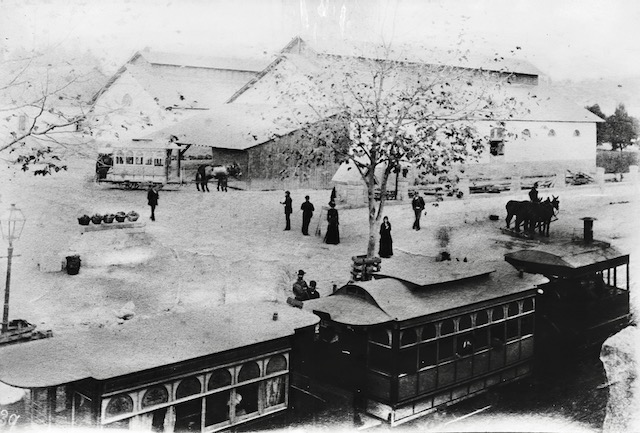
The fleet numbers were 1-6 for the Henschels and 7 for the Merryweather. These fleet numbers were only used since 1886, before the Henschel works numbers or just “Merryweather” were used. In 1884 the Henschels were reported to work with a boiler pressure of 12 atmosphere, the Merryweather with 9 atmosphere.
A mysterious quartet
In 1886 four more steam tram locomotives were acquired, this time second hand from France. They got the numbers 8-11.
No indications were found in the archives about the brands of these four locomotives. They were shipped from Cette (nowadays Sête) to Lisboa and from there by train to Porto. However the development of the steam trams did begin only in the mid-1870s. Most steam tram networks came into existence after 1886. Moreover Cette/Sête, is and was only a small harbour of regional importance. The only steam tram system in that area before 1886 was in Béziers and likely was operated with second hand locomotives from the Tramways du Sud in Paris.
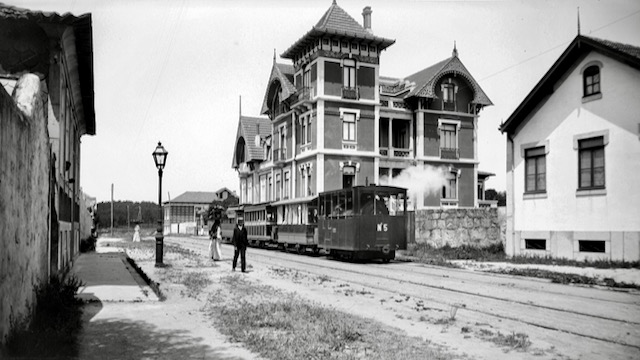
Tramways de Paris – Réseau Sud operated steam trams from November 1875 until February 1878. Laederich2 says these “petites locomotives d’origine anglaise” were not only used in Paris, but also in Rouen from December 1877 until 1896, and Béziers from July 1879 until September 1882. This suggests that the Béziers locomotives were small type Merryweathers. If it were the Béziers locomotives that went in 1886 to Porto, for which is no further evidence, then remains the question what happened with them in the four intermediate years and why they were in Cette/Sête. A guess is that they were used with the major harbour works that were executed in Sête in that period. But apart from the fitting timeline there is no evidence to confirm this theory.
If the locomotives 8-11 were indeed former Paris Merryweathers, then they were smaller and less powerful than the later built no.7. Perhaps these second hand locomotives were acquired to replace the mule traction with steam locomotives during the less busy periods too. Something that was done about the same period.
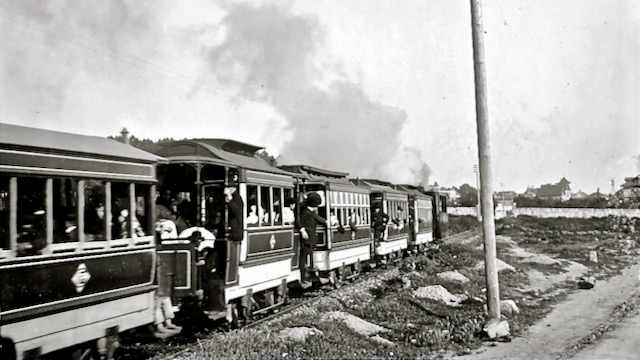
On 17-11-1893 three axles were ordered from Herbert C.Norris & Bastert, 211 Upper Chamey Street – London. Axles for steam locomotives were very specific items. In 1902 the CCFP ordered axles directly from Henschel for the locomotives 1-6. So the 1893 order was not for axles for the Henschel locomotives. Norris & Bastert are not know as producers of locomotives, but appear to have made machine equipment. At that time Merryweather, also based in London, was already out of the locomotive building business. Perhaps they referred for the axles to the for them nearby company. Three axles for only one Merryweather locomotive isn’t plausible. Although no evidence, this 1893 acquirement of axles is an indication the four second hand locomotives were more likely Merryweathers than of another brand.
The locomotives with the numbers 8-10 were sold for scrap to the Companhia Alliança in 1900, number 11 met the same fate in 1903.
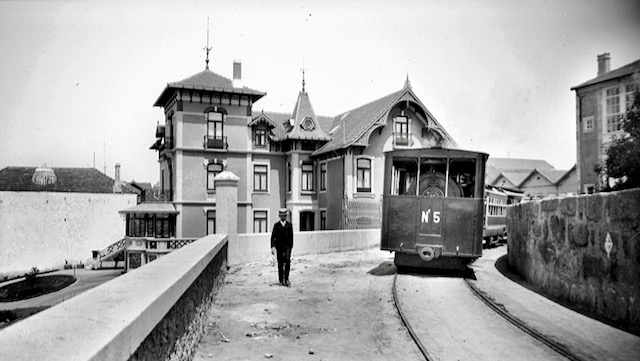
Stronger
In 1900 the locomotives 3 & 7 did get new boilers, followed by the numbers 1, 2 & 4 in 1901 and 5 & 6 in 1903. All the new boilers were supplied by the Companhia Alliança. In a letter to the “Street Railway Review”, 85 Fleet Street London E.C, it was mentioned that the boilers of the locomotives were replaced by more powerful ones about 1901 & 1902.
With the locomotives more powerful, speed could be increased and it was possible to improve the frequency from every 30′ to every 20′. During daytime the locomotives usually hauled three tramcars. During peak hours this was augmented to four or five. In the evenings it often were two or only one.
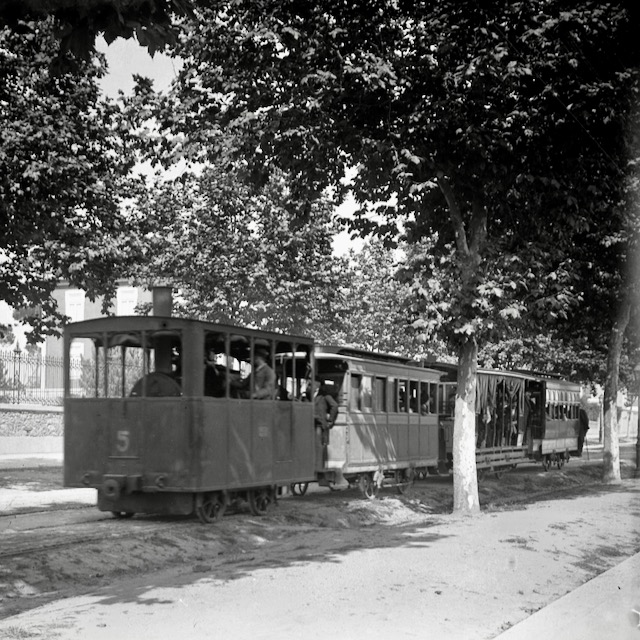
Tragedy
Steam trams were infamous because of the many accidents. As they were heavy but the braking systems were still primitive, it was difficult to make an emergency stop. In Holland all steam trams shared the nickname “Moordenaar” (Murderer). The Porto steam tram wasn’t different and had its share of (fatal) accidents too.
The likely most serious accident was a frontal collision that occurred on 13 October 1911 between two steam trams on the single track section between Rua de Gondarém and Castelo do Queijo. The weather was bad and the trams were running late. A tram coming from Matosinhos and hauled by locomotive no.7 (the Merryweather) didn’t wait in the passing loop at Castelo do Queijo for the crossing with the tram in the opposite direction, but continued with maximum speed. Close to the Rosas stop, In the curve where the line turned into Rua de Gondarém and vegetation obstructed the view, iti smashed into the oncoming tram hauled by locomotive no.3 (a Henschel). The driver of locomotive no.7 died short after arrival in the hospital, the fireman of this locomotive died in the hospital during the night. The driver and firemen of the other locomotive, three conductors and several passengers were wounded, some of them serious. Both locomotives were heavily damaged and because of that the service on the line had to be reduced from every 20 minutes to every 30 minutes until both locomotives were repaired.
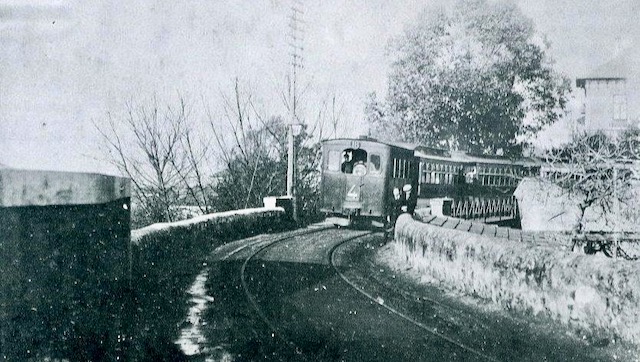
The End
In November 1914 the steam traction was suspended. The route from Fonte da Moura via Cadouços to Matosinhos wasn’t electrified, but replaced by a direct route over the Avenida da Boavista to Castelo do Queijo. However the municipality of Matosinhos didn’t allow double track in Rua Brito Capelo necessary to let both the existing electric tramline no.1 (the former CCA line) and the replacing electric tramline no.5 use this street. Because of this line 5 used Rua Roberto Ivens until 1930.
With the closure of the steam tramline the locomotives went into storage, but 20 November 1916 they were offered for sale:
| 1 | 2 | 3 | 4 | 5 | 6 | 7 |
| 3200$00 | 3700$00 | 3700$00 | 3800$00 | 4000$00 | 2800$00 | 3200$00 |
Sources
Baddeley: “The Continental Steam Tram” by Geoffrey E. Baddeley, published by the LRTA (Light Rail Transit Association) 2nd edition 1982. ISBN 0900433787.
Remark 1: Baddeley gives as source J.H. Price: Tramways of Portugal published in 1964 and with that takes over the wrong claims that
- the steam tram between Foz and Matosinhos was a joint operation of the CCA and CCFP (it was not, both had their own tramlines between Foz and Matosinhos and there was no rail connection between them until the CCFP took over the CCA in 1893 and installed rail connections at Infante and Castelo do Queijo.)
- the locomotives with the Henschel works numbers 972, 986 and 994 were of the CCA with the fleet numbers 1-3 (the CCA never owned steam locomotives, 972 & 994 were CCFP 2 & 3 and 986 never was in Porto)
- the locomotives with the Henschel works numbers 964, 995, 1383 and 1384 had the CCFP fleet numbers 1-2 and 4-5 (it were 1 and 4-6)
- the Merryweather locomotive had the CCFP fleet number 3 (it was 7).
Laederich: “Les Tramways de chez nous” by Pierre Laederich, published by E.T.A.I. in 1998. ISBN 20003130557.
Remark 2: english locomotives page 15: “Des expériences sont tentées à Paris puis à Rouen et Béziers avec de petites locomotives d’origine anglaise“; page 103: use in Béziers of steam tram locomotives from 11 July 1879 until 29 September 1882.
Guido de Monterey: O Porto, Origem, Evolução e Transportes, 2nd edition published in 1972.
Manuel Castro Pereira: Os Velhos Eléctricos do Porto, published in 1995.
John Price: The Tramways of Portugal, 1st edition 1964, 2nd edition 1972, 3rd edition 1883, 4th edition 1985 (3rd & 4th editions together with Brian King) Published by the LRTA.
Remark 1: See remark above with Baddeley.
Own research in the CCFP/STCP archives stored in the Arquivo Distrital do Porto, Rua das Taipas 90 – Porto.
Relics from the past
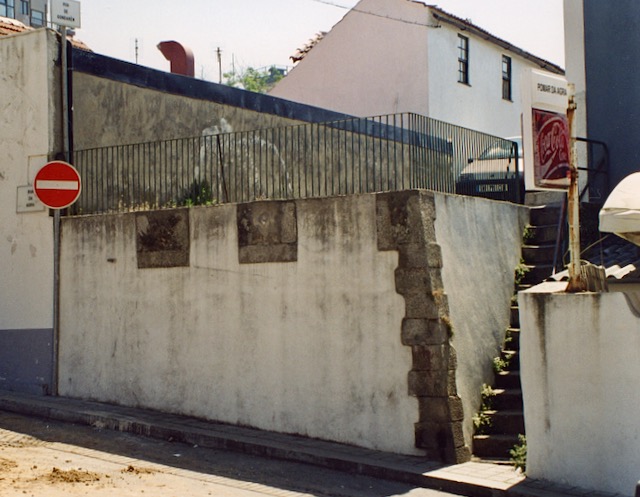
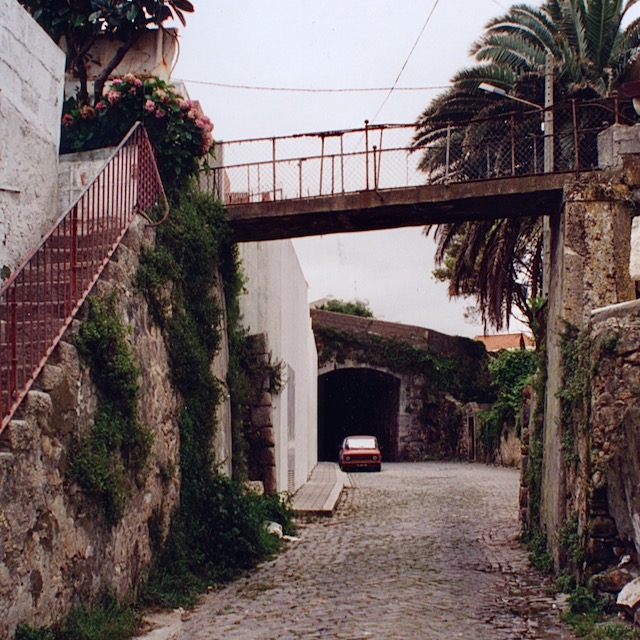

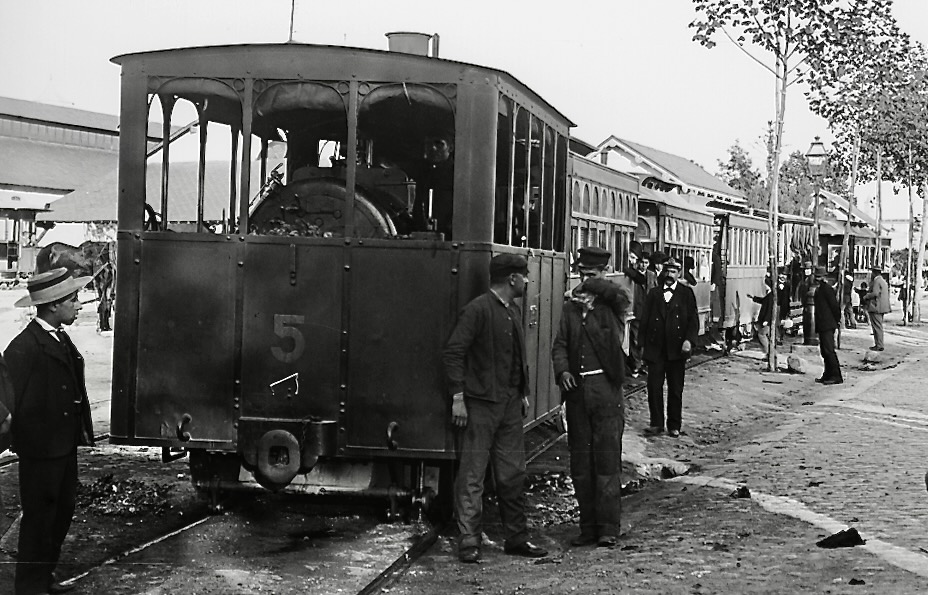
Leave a Reply